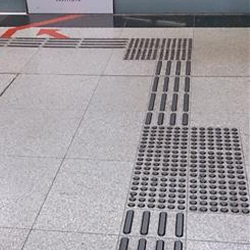
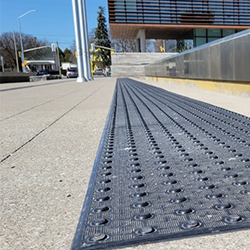
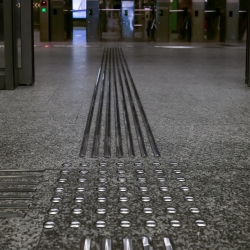
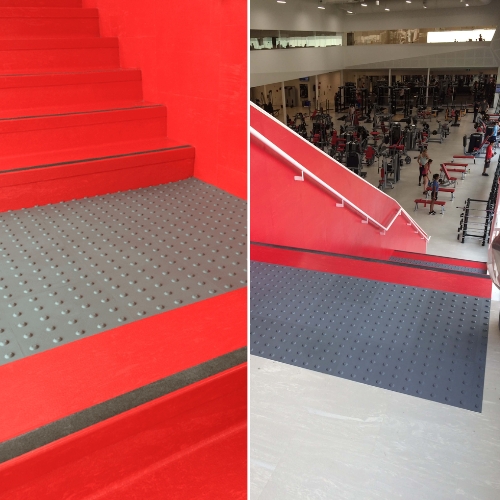
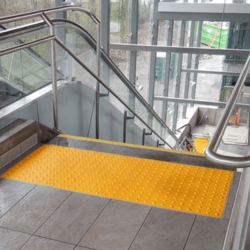
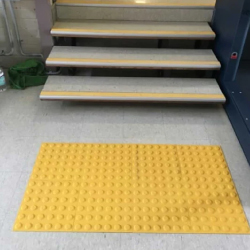
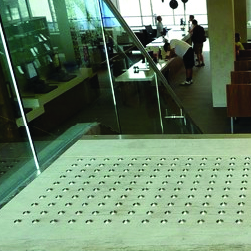
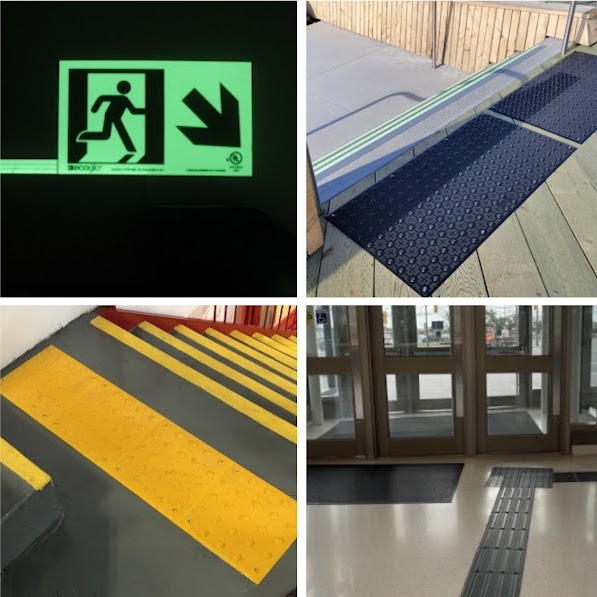

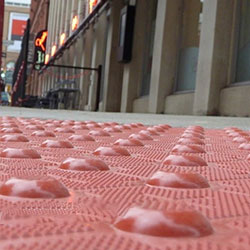
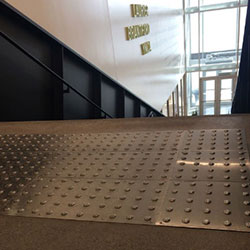
As I entered the local community center for the first time, I felt a mix of curiosity and hesitation. Having recently moved to the area, I was eager to get involved in programs and activities offered here. However, as a person with low vision, unfamiliar spaces often present challenges in accessibility and navigation.
Would I be able to easily find my way around this building independently? Would the environment cater sufficiently to my needs as a visually impaired individual? These nagging questions lingered in my mind.
Upon entering, I was relieved to discover familiar bright green exit signs with photoluminescent strips along staircases and pathways. Tactile attention indicators helped demarcate transitions from the lobby flooring to the wooden gymnasium surface. Directional guidance bars embedded subtly in the floor guided patrons to various sections like the pool and multipurpose rooms.
While the traditional overhead signs did provide helpful information, it was these tactile solutions that transformed my experience from one of apprehension to reassurance. The intuitive sensory cues fostered confidence in freely exploring the center, knowing help was easily accessible if needed.
My story represents countless Canadians who feel empowered by purposeful design choices prioritizing accessibility and inclusion in public spaces. Beyond personal upliftment, universal navigation also minimizes risks, streamlines operations, and manifests foundational societal values commemorated through legislative codes.
In this blog, we’ll explore the unique merits of tactile wayfinding solutions over traditional signage to appreciate their profound impacts, creating enabling, safe environments for people of all abilities.
Signage conveying textual information has been a historical fixture across public infrastructure, providing valuable orientation cues. However, for Canadians with sensory disabilities like blindness or deafness, such visual communication poses innate barriers to comprehension.
Even ambulatory challenges using mobility aids limit individuals’ ability to discern overhead signs comfortably. Without fully accessible navigation tools, many civic services remained largely out of reach for those communities that were intended to benefit.
Spurred by alarming statistics indicating nearly 8 million Canadians live with some form of disability, legislative bodies rallied to address these glaring societal gaps. Instrumental regulations like the Accessibility for Ontarians with Disabilities Act (AODA) now mandate incorporating specialized accessibility solutions to maximize inclusion.
Amongst proven interventions, tactile walking surface indicators (TWSIs) comprising textured ground surfaces provide intuitive guidance for pedestrians with vision loss. Detectable cues like bright contrast colors, raised dots, cones, bars, and raised lettering deliver spatial information through touch, replacing visual perceptual channels.
Today, over a dozen unique tactile solutions facilitate navigation across Canada through alerting, directional, and protective applications:
When thoughtfully embedded in our surroundings, tactile surfaces transcend serving just individuals with disabilities towards benefiting universal access. Let’s explore the key benefits of making tactile elements the preferred choice over traditional signs alone.
While overhanging signs provide valuable wayfinding information, tactile elements on ground surfaces leverage multiple human senses for comprehensively accessible navigation. Some unique advantages include:
These advantages culminate in effortless understanding and facilitate confident mobility, unlike traditional visual cues alone. When properly practiced over lifelong exposure, tactile navigation develops into acquired intuition, furthering ease, safety, and speed of public space usage.
Beyond promoting inclusion, the tactile installation provides measurable risk and liability cost reductions from prevented injuries. As per research, inadequate lighting paired with uneven surfaces elevates falls, contributing to ~40% of all injury deaths among Canadian seniors annually.
However, thoughtfully embedding standardized safety tactile solutions helps drive down preventable harm. Anti-slip stair nosings and guarded edges through tiles prominently alerting level changes demonstrate proven interventions.
In fact, over a decade of studies within the City of Toronto’s facilities retrofitted with tactiles recorded a precipitous 60% decline in slip & fall incidents after installation. The economic value from lives preserved and long-term care costs averted upheld investments many times over.
Canada’s quickly graying population intensifies the need for accessible design accommodating elderly citizens experiencing natural mobility declines. Age-related vision conditions like cataracts, glaucoma, and yellowing lenses compromise the legibility of overhanging signs.
However, tactile walking surfaces provide crucial support aiding stability, balance, and orientation using intrinsic sensory feedback. Community senior centers, assisted homes, and accessible sports programs stand to enhance participation and quality of life through proactive tactile installation.
While traditional signage relies solely on condensed textual information, tactile guidance ties spatial awareness together using multiple modalities. Handrails lead along directional bars, synchronizing movement cues for seamless transitions. Colored domes distinguish unique paths at junctions where written descriptors often overflow cognitive bandwidth.
Tactile architecture refines routes, freeing mental resources to enjoy experiences, conversations, and scenic details other senses reveal. Unburdened navigation cultivates confidence to fully inhabit environments.
Chaotic crisis events like fires intrinsically disguise visual cues occupants rely on daily for wayfinding. However, photoluminescent and anti-slip stair nosings continue emitting guidance when stunned infrastructure fails. High contrast marking bounded by texture gradients leads evacuees of varied abilities literally to safety thresholds.
The life-preserving difference conveys why the National Building Code mandates such reliable fail-safes for spatial legibility in obscuring emergencies. Tactilely enhanced structures promote intuitive escape, saving lives when seconds matter the most.
Beyond functionality, thoughtfully blending guidance elements into pavings elevates aesthetic appeal, promoting usage beyond those requiring solutions accommodating disabilities. For example, heritage sites sensitively balance preserving historical provenance through harmoniously embedding accessible upgrades.
Fine porcelain tiles and metallic domes are thoughtfully incorporated into the stonework, timber, and paved landscapes. Far from unsightly add-ons, cohesive designs promote engaging spaces that welcome enjoyment from all demographics.
Many structures lacking past accessibility foresight now demand upgrades meeting modern codes. However, modifying entrenched frameworks risks astronomical costs and operational disruption. Efficient surface-adhered tactile plate solutions upgrade existing setups without invasive demolition. New-builds similarly benefit from cost-efficient “stick on” tactile sheets, simplifying planning. The minimal effort maximizes access for more inclusive hospitals, transit platforms, and other essential infrastructure requiring uncompromised access.
As Canada progresses equitably in integrating disabled communities, sustained growth relies on innovating beyond minimum compliance. Holistic inclusion spurs organizational excellence, public goodwill, and participatory citizenship, improving socioeconomic outcomes that benefit all Canadians.
For years, industry leaders like Tactile Solutions Canada diligently researched, tested, and supplied an exhaustive range of sensory wayfinding solutions that transform indoor and outdoor spaces across provinces.
Rigorously vetted products like Access Tile, Ecoglo, Advantage Tile, Elan Tile, and Eon Tile meet AAA-level accessibility standards from AODA, CSA, and the National Building Code, raising the bar in promoting mobility. Ongoing disability workshops actively co-create new paradigms embedding inclusive thinking into everyday design.
The next time you encounter thoughtfully embedded tactile directional cues or warning indicators amidst floors, recognize the conscientious choice upholding inclusion as an indispensable societal value built to last decades. One senses quickly how purposeful design transforms sterile spaces into welcoming sanctuaries promoting dignity, confidence, and autonomy for citizens of all abilities indistinguishably.
